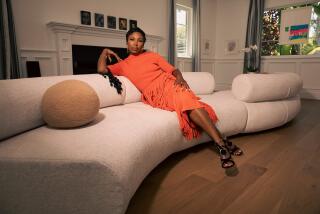ART REVIEW : Essence Proves to Be Only Skin Deep : The work of Rachel Lachowicz, an artist for the Age of Madonna, is at the Newport Harbor Art Museum through Sunday.
- Share via
NEWPORT BEACH — “Will you still love me when I’m 88?” Face to face with Rachel Lachowicz’s three mask-like versions of herself--at 28 (her current age), 58 and 88--a viewer muses on the changing way the world sees a woman as she ages, and on the mythology of makeup in our culture.
Metamorphosing from taut-skinned expressionlessness to a lined and pouchy scowl, the row of uptilted plaster faces in “Forensic Projection--Self-Portrait” improbably are covered with the same dewy tint, from the Chanel “poudre douce” line.
The piece exaggerates both the artificiality and the conventionality of makeup as a uniform for the female face, a sign that male attention is expected and desired. Conceived by a young woman, the piece projects a woman’s fear of aging from a coolly distanced viewpoint: a cosmetics counter display with the authoritative look of a bulletin from the medical world.
Lachowicz, a Los Angeles artist whose recent work is at the Newport Harbor Art Museum through Sunday, is as different from ‘60s-style feminist artists as Camille Paglia, author of “Sexual Personae,” is from Susan Brownmiller (“Against Our Will”). The simplicity--some might say simple-mindedness--of Lachowicz’s approach and her fascination with external qualities gives her work a sassy, flirtatious appeal.
No cerebral heavyweight, the CalArts graduate is an artist for the Age of Madonna, an era when female empowerment can mean artful use of man-trapping devices, when sheer outrageousness becomes a shrewd marketing tool. The immediate pleasures of her work have a disconcerting way of evaporating the longer you think about them.
In photographs of her recent “Red Not Blue” performance at Shoshona Wayne Gallery in Santa Monica included in the current exhibit, the artist wore a modishly short black cocktail dress, black hose and heels as she applied red lipstick to the upper arms, torso, thighs and penis of a nude man whose prone body left a skeletal imprint on a canvas.
“Full-Body Print (Dark)” is Lachowicz’s answer to French artist Yves Klein’s “Anthropometries.” In those famous studio happenings of the late 1950s, nude women covered with blue paint served as human brushes painting blank canvases with their bodies, to the erotic amusement of the audience. In Lachowicz’s “print,” the man’s body shrivels into a brash yet depersonalized human cipher.
Lachowicz frequently uses makeup as a paint-substitute in her reinterpretations of famous gestures by male artists. Responding--nearly 80 years after the fact--to Marcel Duchamp’s act of inverting an ordinary urinal and thereby turning it into a work of art (“Fountain”), she presents three plaster casts of urinals, “enameled” in melted red lipstick and shown right-side up.
Applying red lipstick is Lachowicz’s show-off tactic for canceling out the work’s reference to the male organ and its association with a famous male artist. Presented in eye-pleasing triplicate, the urinals might be stand-ins for the female nudes in the “Three Graces.” The sexual connotation of lipstick comes into play here, too: It calls attention to the mouth but also relates to a similar orifice hidden from public view.
In a vamping remake of Gerhard Richter’s color chart paintings of the late 1960s and early ‘70s, Lachowicz makes three “paintings” assembled with eye makeup colors. The familiar rectangular compartments--grouped in various patterns--hold the arbitrary hues designated by the fashion industry, a language of color meaningful only to those who worship its whims.
Lachowicz’s backhanded tributes don’t really question the validity of famous artists’ work. Rather, they teasingly suggest various possibilities inherent in substituting a woman-based view of the world. Unlike old-style feminist art, in which fingers are pointed and accusations are made, Lachowicz’s work has a playful, show-off side and a streak of petulant humor.
One exception, however, is “Black and Blue,” based on Max Ernst’s witty but hardly egalitarian chess-themed sculpture, “The King Playing With the Queen,” shown at Newport Harbor last summer and which was just sold at Sotheby’s fall auction for $1.2 million. In the Ernst piece, the King protectively encircles the pint-sized Queen with one arm and hides a breast-shaped pawn behind his back.
In Lachowicz’s version, a metal chain hitches the tall black King to an enlarged blue poker chip imprinted with a Queen lying on her back. The bruise image evoked by the title is reinforced by her subservient posture, her comparative size, her “imprisonment” within the poker chip and the chain itself, which looks like a dog leash. But why a poker chip? Because men consider women as “stakes” in the “game of life”?
The male-female role-playing in this piece has a rigid, stereotypical quality that reveals Lachowicz’s weakness in grappling with issues, as opposed to presenting tantalizing surfaces. Her work seems best when it’s all dolled up in a smart-looking wrapper that doesn’t encourage the viewer to peek inside.
* Ne w California Art: Rachel Lachowicz,” through Sunday at Newport Harbor Art Museum, 850 San Clemente Drive, Newport Beach. Today through Sunday, 10 a.m. to 5 p.m.
More to Read
The biggest entertainment stories
Get our big stories about Hollywood, film, television, music, arts, culture and more right in your inbox as soon as they publish.
You may occasionally receive promotional content from the Los Angeles Times.










